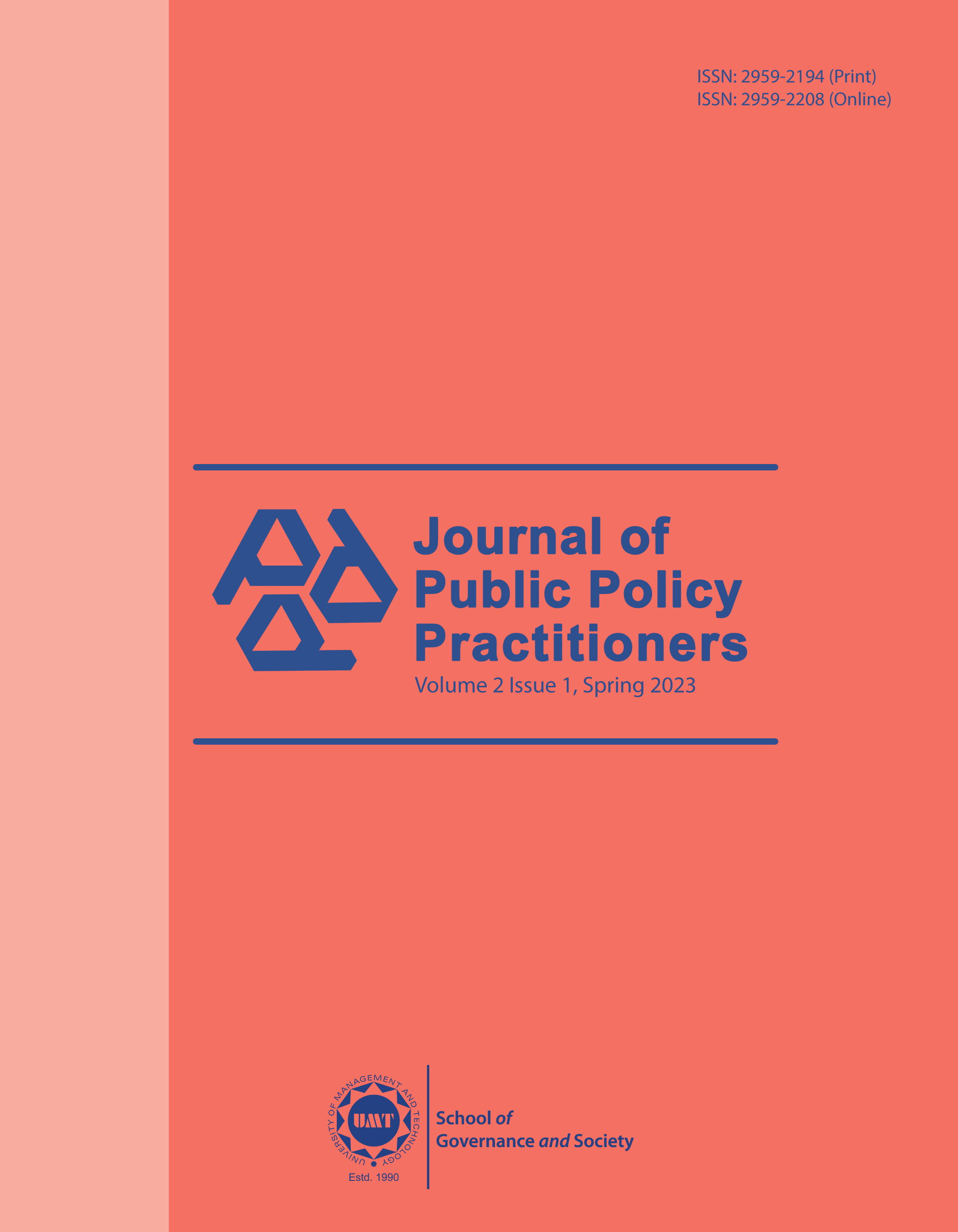Interactive Learning Interfaces to Enhance Student Engagement and Performance in the Government Education Sector of Higher Schools of Punjab
Abstract
 Abstract Views: 0
Abstract Views: 0
Punjab is Pakistan's largest province and according to the School Census of Punjab, there are around 12.86 million students enrolled in public schools, and there are 391,799 teachers working in 52,470 public schools, resulting in a 33:1 student-teacher ratio. Pakistan as a whole and Punjab province both have literacy rates of above 70%, yet this is not a real reflection of Pakistan's educational system. Punjab’s current educational policy has major flaws, including high student-teacher ratio, uneven distribution of teachers with scarcity in rural regions, deteriorating educational outcomes, a declining proportion of children who attend government schools, declining proportion of public-school graduates working in white-collar jobs, increasing number of out-of-school children (“Punjab Province”, 2018), and many others. Pakistan needs to enhance its public education system not only to tackle economic, social, and developmental challenges but also to meet international commitments like the Sustainable Development Goals (SDGs). The digital revolution, driven by technological advancements, has transformed various industries, including education.
This shift allows the adoption of Learning Management Systems (LMS) in higher education institutions within Punjab's government education system. By replacing traditional textbooks with digital content and utilizing interactive learning interfaces, policymakers and educators can create a more effective and engaging learning environment. The study's implications extend beyond Punjab, serving as a valuable guide for similar programs globally aiming to enhance student performance and engagement in government schools.
Downloads
References
Abid, N., Ali, R., & Akhter, M. (2021). Exploring gender‐based difference towards academic enablers scales among secondary school students of Pakistan. Psychology in the Schools, 58(7), 1380–1398. https://doi.org/10.1002/pits.22538
Aslam, M. (2009). The relative effectiveness of government and private schools in Pakistan: Are girls worse off? Education Economics, 17(3), 329–354. https://doi.org/10.1080/09645290903142635
Awan, A. G., & Zia, A. (2015). Comparative analysis of public and private educational institutions: A case study of district Vehari Pakistan. Journal of Education and Practice, 6(16), 122–130.
Aziz, M., Bloom, D. E., Humair, S., Jimenez, E., Rosenberg, L., & Sathar, Z. (2014). Education system reform in Pakistan: Why, when, and how? (Policy Paper No. 76). https://docs.iza.org/pp76.pdf
Balane, M. A., Palafox, B., Palileo-Villanueva, L. M., McKee, M., & Balabanova, D. (2020). Enhancing the use of stakeholder analysis for policy implementation research: towards a novel framing and operationalized measures. BMJ Global Health, 5(11), Article no. 002661. https://doi.org/10.1136/bmjgh-2020-002661
Career Ride. (n.d.). Private or government school-which is better? https://www.careerride.com/view/private-or-government-school-which-is-better-16065.aspx
Cooper, B. R., Moore, J. E., Powers, C. J., Cleveland, M., & Greenberg, M. T. (2014). Patterns of early reading and social skills associated with academic success in elementary school. Early Education and Development, 25(8), 1248–1264. https://doi.org/10.1080/10409289.2014.932236
Fernández-Soriano, F. L., López, B., Martínez-España, R., Muñoz, A., & Cantabella, M. (2019). Use of computing devices as sensors to measure their impact on primary and secondary students' performance. Sensors, 19(14), Article e3226. https://doi.org/10.3390/s19143226
Ghazi, S. R., Ali, R., Khan, M. S., Hussain, S., & Fatima, Z. T. (2010). Causes of the decline of education in Pakistan and its remedies. Journal of College Teaching and Learning, 7(8), 9–18. https://doi.org/10.19030/tlc.v7i8.139
Government of the Punjab. (2018). School education department. https://schoolportal.punjab.gov.pk/sed_census/
Hamlin, D. (2021). Can a positive school climate promote student attendance? Evidence from New York city. American Educational Research Journal, 58(2), 315–342. https://doi.org/10.3102/0002831220924037
Islamabad Policy Research Institute. (2015, March 2). Education system of Pakistan: Issues, problems and solutions. https://ipripak.org/education-system-of-pakistan-issues-problems-and-solutions/
Lim, H. J., & Kim, J. (2011). A longitudinal study of children’s social behaviors and their causal relationship to reading growth. Asia Pacific Education Review, 12(2), 197–213. https://doi.org/10.1007/s12564-010-9124-y
LUMS achieves highest pass ratio in CSS exams 2016. (2016, December 27). Daily Times. https://dailytimes.com.pk/38173/lums-achieves-highest-pass-ratio-in-css-exams-2016/
Pitman, P. M. (n.d.). Research methods, Part II: Policy options analysis. https://www.chds.us/coursefiles/NS4081/lectures/methods_policy_options_analysis_v02/methods_policy_options_lec_v02.pdf
Punjab province has the highest number of out of school children in the world: Report. (2018, April 27). Times of Islamabad. https://timesofislamabad.com/27-Apr-2018/punjab-province-has-the-highest-number-of-out-of-school-children-in-the-world-report
Strunk, T. A. (2014). An exploration of the relationships between academic enablers and middle school achievement [Doctoral dissertation, Pennsylvania State University]. Pennsylvania State University Libraries. https://etda.libraries.psu.edu/catalog/23618
Tsai, H., & Liu, S. (2015). Relationships between time-management skills, Facebook interpersonal skills and academic achievement among junior high school students. Social Psychology of Education, 18(3), 503–516. https://doi.org/10.1007/s11218-015-9297-7
UNICEF. (2018). Annual report Pakistan. https://www.unicef.org/pakistan/media/2021/file/Annual%20Report%202018%20Revised%20Final.pdf
Walberg, H. J. (1981). A psychological theory of educational productivity. In F. Farley & N. J. Gordon (Eds.), Psychology and education: The state of the union (pp. 81–108). McCutchan.
Wentzel, K. (2012). Part III commentary: Socio-cultural contexts, social competence, and engagement at school. In S. Christenson, A. Reschly & C. Wylie (Eds.), Handbook of research on student engagement (pp. 479–488). Springer.
Copyright (c) 2023 Arqam Tariq, Muhammad Waseem Iqbal, Hinna Hafeez, ZaibunNisa

This work is licensed under a Creative Commons Attribution 4.0 International License.







